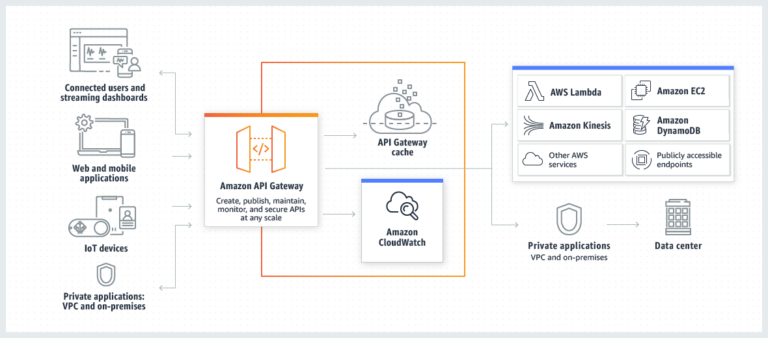AWS API Gateway
Introduction
In today’s cloud computing landscape, creating & managing APIs for your application development is crucial. AWS API Gateway is an AWS Service for publishing, monitoring, securing, and maintaining APIs. This Service is fully managed and is available through the AWS Management Console, where you can create an API in a few clicks. In this blog we will explore AWS API Gateway, its architecture, features, use cases, and benefits.
This blog will guide you through the essential aspects of AWS API Gateway, covering the following topics:
- What is AWS API Gateway?
- Architecture of AWS API Gateway
- Key Features of AWS API Gateway
- Use Cases of AWS API Gateway
- Benefits of Using AWS Lambda
- Accessing API Gateway
What is AWS API Gateway?
Amazon API Gateway is an AWS service for creating, publishing, maintaining, monitoring, and securing REST, HTTP, and WebSocket APIs at any scale. API developers create APIs that can access AWS or other web services, any data stored in the AWS Cloud. This service lets you configure an API to give applications access to data, functionality, or business logic from back-end services, including:
- Any web application.
- Applications running on AWS services, such as Amazon Elastic Container Service (Amazon ECS) or Amazon Elastic Compute Cloud (Amazon EC2).
- Code running on AWS Lambda.
You can also make your APIs available to third-party application developers.
Architecture of API Gateway
This diagram illustrates how the APIs you build in Amazon API Gateway provide you or your developer customers with an integrated and consistent developer experience for building AWS serverless applications. API Gateway handles all the tasks involved in accepting and processing up to hundreds of thousands of concurrent API calls. These tasks include traffic management, authorization and access control, monitoring, and API version management.
API Gateway acts as a “front door” for applications to access data, business logic, or functionality from your backend services, such as workloads running on Amazon Elastic Compute Cloud (Amazon EC2), code running on AWS Lambda, any web application, or real-time communication applications.
Key Features of API Gateway
Here are the key features of AWS API Gateway
- Versatile API Support: Support for stateful (WebSocket) and stateless (HTTP and REST) APIs.
- Robust Authentication: Powerful, flexible authentication mechanisms, such as AWS Identity and Access Management policies, Lambda authorizer functions, and Amazon Cognito user pools.
- Canary Releases: Canary release deployments for safely rolling out changes.
- Comprehensive Logging: CloudTrail logging and monitoring of API usage and API changes.
- Custom Domains: Support for custom domain names.
- Automated API Creation: Ability to use AWS CloudFormation templates to enable API creation.
Use Cases of AWS API Gateway
Here are few Use Cases of API Gateway service:
- Serverless Application Development: You can build & deploy serverless applications with the help of AWS Lambda by connecting front-end clients to back-end.
- Microservices Architecture: You can manage and scale microservices by checking individual services through APIs.
- Authentication and Authorization: You can easily secure APIs with AWS IAM, Lambda authorizers, or Amazon Cognito for user access control.
AWS API Gateway Benefits
Here are the benefits of AWS API Gateway:
- Scalability: This API Gateway is elastic, giving it the ability to scale-out and scale-in dynamically without manual configuration in order to handle changing traffic and provide low latency.
- Security: API Gateway can function as a security barrier for the sensitive endpoints of an API, which will protect APIs from attacks by DoS, SQL injections and other malicious attacks.
- Flexibility: The API Gateway supports different type of API that includes REST, HTTP, and WebSocket. This allows developers to choose the best possible approach for the case of use.
- Integration with other AWS Services: API Gateway can easily integrate with other AWS services such as AWS Lambda, Amazon EC2, Amazon Kinesis, and AWS Step Functions, enabling serverless and microservices architectures.
Accessing AWS API Gateway
You can access Amazon API Gateway in the following ways:
- AWS Management Console
- AWS SDKs
- API Gateway V1 and V2 APIs
- AWS Command Line Interface
- AWS Tools for Windows PowerShell
Conclusion
In summary, AWS API Gateway is a valuable service for creating and managing APIs easily and securely. It offers essential features like scalability and integration with other AWS services, making it ideal for developers building modern applications. Whether you’re working on serverless projects or microservices, API Gateway can help streamline your API management and enhance your cloud solutions.
By – Dheeraj Sain
